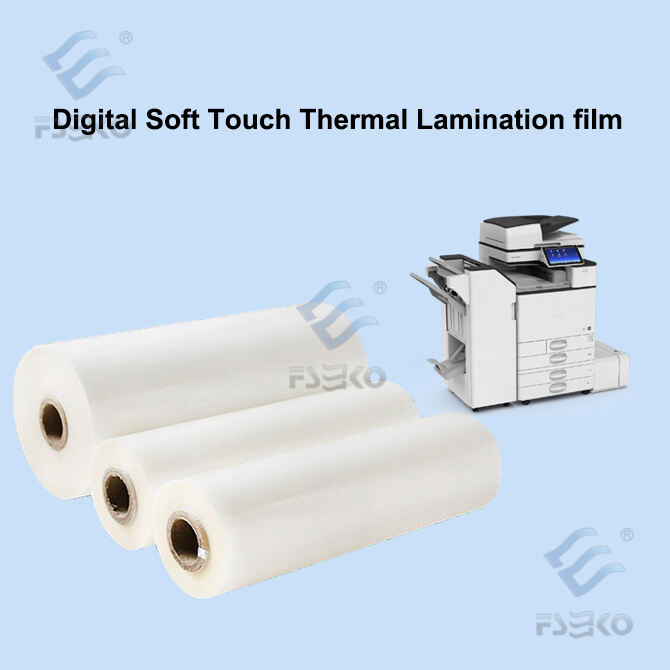Introduction to Digital Soft Touch Thermal Lamination Film
Digital soft touch thermal lamination film is a protective layer that enhances both the durability and aesthetic appeal of printed materials. This specialized lamination process uses heat and pressure to seamlessly bond the film to the substrate, resulting in a smooth, luxurious finish. The soft-touch surface not only creates a pleasant tactile experience but also contributes to the longevity of printed materials by guarding against external elements such as moisture and physical damage.
This type of lamination film is particularly valued in industries where presentation is essential. For example, luxury packaging, premium printing, and marketing collateral greatly benefit from this film's distinct characteristics. The film provides low glare and a velvety finish, setting it apart from standard laminating films. By using digital soft touch thermal lamination, businesses can significantly elevate the look and feel of their print products, making them more engaging and memorable to the end-users.
Key Applications Across Industries
Post-Press Processing Enhancements
Thermal lamination film plays a crucial role in post-press processing by providing an added layer of protection to printed materials. This application is pivotal in industries like publishing and marketing where the durability of printed items is essential. The film enhances the final product's resilience, reducing wear and tear and ensuring longer-lasting prints. By incorporating lamination, materials become more robust and resistant to common damages, thus improving the overall quality of deliverables and customer satisfaction.
Luxury Packaging Solutions
In the realm of luxury packaging, soft touch thermal lamination films are often utilized to create an exquisite tactile experience. This application serves more than just a protective purpose; it also elevates the brand's visual appeal and luxury quotient. Statistics indicate that packaging with enhanced tactile elements can significantly boost consumer purchasing intention. Soft touch films add a velvety layer to packaging materials, communicating a sense of opulence and reinforcing brand prestige, making them a valuable asset for high-end brands aiming for premium presentation.
Flexible Packaging for Durability
For flexible packaging solutions, thermal lamination film provides a dependable barrier against moisture and harmful chemicals, which is essential for preserving the shelf life of food and other perishable products. Its adaptability to various shapes makes it suitable for packaging a wide array of goods. This attribute is particularly beneficial in the food industry, where products require airtight protection to maintain freshness and extend usability. The use of lamination in flexible packaging underscores its role in enhancing both functionality and durability.
Electronics Component Protection
The electronics industry benefits significantly from the protective properties of thermal lamination films. These films safeguard sensitive components from abrasion and environmental threats, thus maintaining their performance and integrity over time. This is especially important in environments where devices are exposed to harsh conditions. By employing lamination films, electronics manufacturers can ensure the long-lasting reliability of components, thereby supporting the quality and durability expected by consumers and professionals alike.
Architectural and Construction Uses
In architecture and construction, thermal lamination films are employed to protect essential documents such as blueprints and design presentations. The water and tear-resistant attributes of the film make it an ideal choice for safeguarding materials that are crucial in planning and executing building projects. By ensuring that these documents remain intact and legible throughout the construction process, lamination films contribute to the smooth execution and success of architectural endeavors. This application highlights the versatility of lamination films in providing both functional and aesthetic benefits across different sectors.
Advantages of Using Thermal Lamination Film
Enhanced Durability and Scratch Resistance
Thermal lamination film serves as an integral protective layer, significantly boosting the durability of printed materials. This protection is paramount as it defends against scratches and the daily wear and tear that materials commonly face. By extending the lifespan of items such as posters, book covers, and business cards, thermal lamination reduces the need for frequent reprints, ultimately saving both time and resources. The robust nature of this film makes it an indispensable tool in environments where printed materials encounter high traffic or handling.
Premium Aesthetic Appeal with Soft Touch Finish
The allure of a premium soft-touch finish is not to be underestimated, especially when aiming to enhance consumer perception and experience. Thermal lamination films with a soft-touch finish offer a luxurious feel that resonates strongly with consumers, particularly in sectors that emphasize high-end product presentation. This tactile advantage adds a sense of sophistication which can elevate the perceived value of printed materials. Such an enhancement is especially prized in industries like luxury packaging, where the quality of touch can be as persuasive as the visual appeal.
Moisture and Chemical Protection
In environments where exposure to moisture and chemicals is a risk, thermal lamination film acts as a resilient barrier. It is especially critical in sectors such as food and pharmaceuticals, where safeguarding products from potentially damaging external conditions is a necessity. This protective quality ensures that documents, labels, and other sensitive materials maintain their integrity, even when subjected to adverse environments. As a result, products protected by thermal lamination film are better equipped to withstand the elements, thus preserving their usability and appearance over time.
Innovations in Thermal Lamination Technology
Eco-Friendly Recyclable Film Options
Recent advancements in thermal lamination technology have led to the development of eco-friendly, recyclable film options, addressing growing consumer concerns regarding sustainability. These innovations play a critical role in reducing waste and the carbon footprint associated with lamination products. Eco-friendly films are crafted to meet environmental standards without compromising on performance, thus offering businesses a sustainable choice for packaging and lamination needs.
Advanced Adhesive Formulations
Innovative adhesive formulations are advancing the bonding strength and versatility of thermal lamination films. These new formulations allow for stronger adhesion across various substrates, including paper, plastics, and textiles, under varying conditions. Enhanced bonding capabilities increase the reliability of lamination processes, ensuring greater compatibility with digital printing technologies and expanding their application across different industries.
High-Speed Compatibility with Digital Printing
The latest thermal lamination films demonstrate high-speed compatibility, making them ideal for modern digital printing processes. This innovation allows manufacturers to efficiently produce high-quality laminated materials without sacrificing clarity or resolution. As digital printing continues to evolve, lamination films that support rapid processing while maintaining top-notch aesthetics become essential in catering to high-demand sectors like advertising and publications.
Best Practices for Applying Thermal Lamination Film
Surface Preparation Techniques
Proper surface preparation is the cornerstone for effective lamination. It's crucial to begin by cleaning the substrate thoroughly, ensuring it is free from dust and contaminants. This step is essential for optimal adhesion and performance of the thermal lamination film. Neglecting surface preparation can lead to bubbles, wrinkles, and poor overall adhesion, impacting the quality and durability of the laminated product. By dedicating attention to this preliminary step, you set the stage for successful application of the film.
Temperature and Pressure Optimization
Adjusting the temperature and pressure settings according to different film types and substrates is vital for achieving the desired lamination outcomes. Each type of lamination film has unique specifications, and adhering to manufacturer recommendations ensures better finishes and prevents common issues such as film wrinkles or bubbles. This process not only improves the visual appeal of the finished product but also enhances its performance and longevity. By optimizing these settings, you can tailor the lamination process to suit specific requirements.
Choosing Equipment for Office vs Industrial Use
When selecting laminating equipment, it's important to consider the scale of operation and the intended application. For office settings, compact and user-friendly machines are ideal, as they are designed for ease of use and efficiency on a smaller scale. Conversely, industrial applications demand high-capacity, heavy-duty equipment capable of handling larger volumes and more demanding conditions. Understanding the needs of your operation ensures that you choose the appropriate machinery to maximize productivity and efficiency in your lamination processes.


